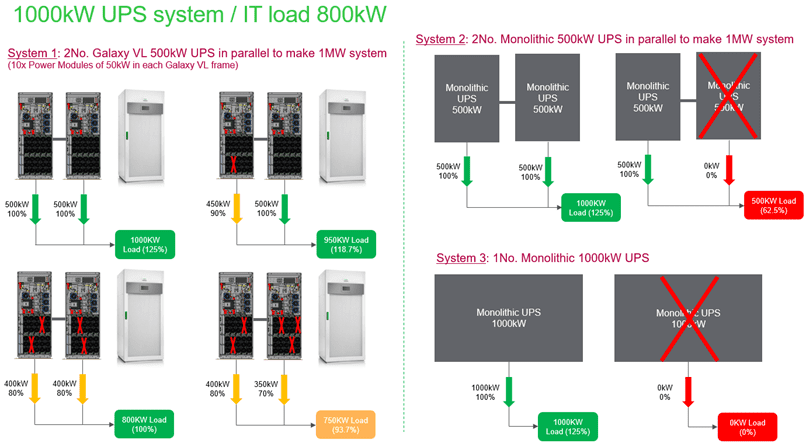Modular After years of debate, and extensive comparison of monolithic and modular UPS designs, consumers are reaching a consensus: the best 3-phase UPS is a modular 3-phase UPS. As the pain points of the modular UPS disappear, and customers need to control operating costs, the added value of modular design is not just visible – it’s essential.
Modularity has become synonymous with flexibility, optimization, simplification, operability and much more. Many of us have fond childhood memories of working with Lego bricks, carefully choosing small pieces of various shapes and colours to build cars, planes, houses, and more. After learning that we can use simple blocks to bring our inspiration and imagination to life, why not reuse this brick concept to design a modular UPS? This idea transformed power protection, as new redundancy schemes have intensified expectations for ultra-high-power availability and fast Mean Time To Repair (MTTR).
Modular platforms enable manufacturing innovations
Modular platforms also enable manufacturing innovations that optimize the consumer’s costs and user experience. For example, when Volkswagen developed a modular platform, with cars sharing the same chassis, engine, and other parts, they cut car manufacturing time by 30%. Even better, customers enjoyed price optimization, thanks to economies of scale; fuel efficiency, because the lighter chassis reduced fuel consumption; and safer road handling, with safety features standardized across the platform. Manufacturers in the 3-phase UPS industry likewise understand that modularity is the key to delivering outstanding customer experiences for customers with a diversity of needs and expectations.
Knowing that a modular platform makes power protection products more reliable, more sustainable, and more efficient, Schneider Electric launched the Galaxy V series platform in 2019. Today, the Galaxy V-series platform includes Galaxy VS (10-150 kVA/kW) and its big brother, Galaxy VL (200-500 kVA/kW). The two UPSs feature an interchangeable 50kW power module, as well as other shared hardware and firmware components. Integrating modularity into the core of the platform has several benefits; first, let’s explore reliability.

UPS reliability is the top critical mission
For most data center customers, reliability is the top critical mission of the UPS. Resiliency is a key benefit of a modular platform, thanks in part to component standardization. Modularity gives manufacturers the opportunity to reuse what has worked well in the product, and to increase its robustness with each new iteration by integrating lessons learned and best practices into the design of each module. This makes a critical product like the 3-phase UPS more reliable.
Increasing availability and reducing MTTR is another strong benefit of modular UPSs with one or more redundant power modules. Look at Figure 1, where you see three different 1MW UPS system configurations that are supporting an 800kW critical IT load:
- System 1 uses two modular 500 kW UPSs, populated with ten 50 kW power modules each
- System 2 uses two monolithic standalone 500kW UPSs
- System 3 is a full 1 MW monolithic standalone UPS
In case of outage, different scenarios will happen. With System 3, you will entirely lose the IT load. With System 2’s architecture of two monolithic UPS in parallel, if you lose one unit, you can only continue to run at 500kW (62.5% of 800kW IT load).
Now if you take the fully modular System 1 architecture of two UPS in parallel, the scenario is very different. If one 50kW power module is disabled, nothing happens, as you can still support 950kW IT load. Even if up to four power modules are disabled, the IT load is fully secured by the system. You would have to lose five power modules to be in trouble. In this case, the system could only support 750kW, so the 800kW system would switch to bypass. Of course, an outage could be caused by the static bypass or the controller module of the UPS. However, for both monolithic and modular UPSs, power components in the conversion path are the root cause of UPS outage in 9 out of 10 cases. Modular design enables redundancy of those power components, and cost-effectively improves system availability.

Adopting a modular platform
In part 2 of this blog, we will discuss how adopting a modular platform has improved UPS efficiency, footprint, and ease of operations. To learn more about optimizing the availability of your application, contact Schneider Electric.



